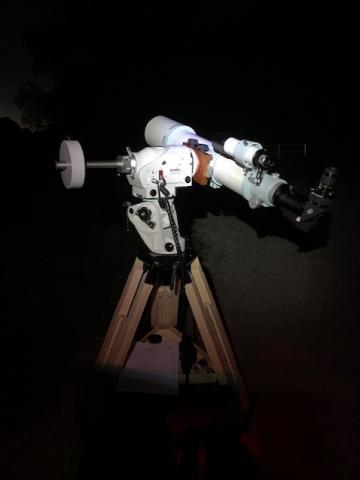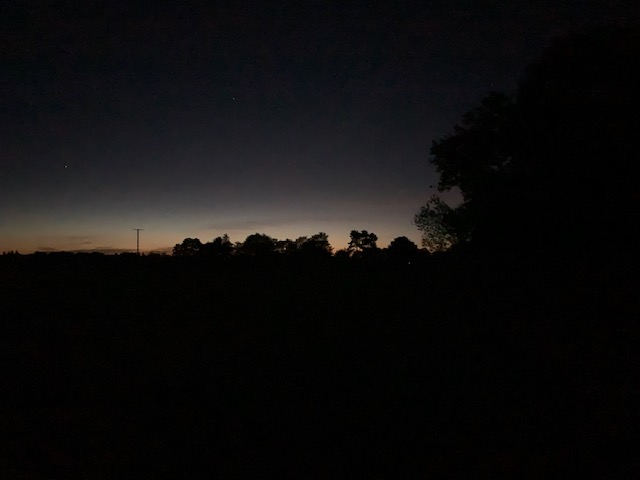Forum Replies Created
-
AuthorPosts
-
 Jeremy ShearsParticipant
Jeremy ShearsParticipantAn Astronomer’s Telegram, ATel #13776, from the Kyoto group publishes a spectrum taken on June 2. This “showed Balmer absorption lines with emission cores, which are typically seen in dwarf nova outbursts. There are no signals of O III, which were reported in the 1988 outburst”, although they question the 1988 conclusion.
 Jeremy ShearsParticipant
Jeremy ShearsParticipantI have poor horizons from my obsy, Graeme. But I’m lucky enough to have a second, portable, set up with an AZEQ6 mount which enables me to decamp to more favourable observing locations for special events like this.
 Jeremy ShearsParticipant
Jeremy ShearsParticipantNice work, Tim! Looks like you solved your problem, but just to say I use V-band comparison star data from the AAVSO VSP. Comps for PQ And are listed here. If you used a V-filter on your camera (which I assume is monochrome?), the resulting mags are quoted as CCD-V. If unfiltered they would be CCD-CV.
Thanks for tackling this star!
 Jeremy ShearsParticipant
Jeremy ShearsParticipantMy goodness, Robin! You have certainly given this your best efforts. As you say, remarkable that you got anything given the circumstances!
 Jeremy ShearsParticipant
Jeremy ShearsParticipantGlad you enjoyed the VSS Circular, Daryl.
On the subject of Betelgeuse, we are hoping that Dr Mark Kidger, who wrote about Betelgeuse in this edition and the last one, will speak about the star during a BAA Wednesday webinar. Keep an eye on the webinar listings.
Back numbers of VSSC’s can be accessed here.
 Jeremy ShearsParticipant
Jeremy ShearsParticipantGood to see people overcoming the odds and securing successful observations of PQ And. I managed to see it this morning at about 02.25 BST. I decamped with my 12 cm refractor to a field a mile away and it’s far too low from my obsy as you can see from the angle of my telescope in the dawn sky.


 Jeremy ShearsParticipant
Jeremy ShearsParticipantJames, it’s difficult to say as it’s so dependent on your specific set-up, plus we have a brightening sky to contend with. If we are going to extract photometry from images, the star and its comparisons should not be saturated. This will result in shorter exposures than you might normally consider to get a “pretty picture” (but a pretty picture would also be nice as this is such a rare event!). Thus it’s best is to bracket with a range of exposures. Also avoid saving as a file type that compresses the image, like jpg, as that will involve loss of data.
 Jeremy ShearsParticipant
Jeremy ShearsParticipantMaybe a saw, Robin?
Good luck, though. It would be great to get some spectroscopy.
 Jeremy ShearsParticipant
Jeremy ShearsParticipantQuite right Nick!
Regarding lunar craters, one cater name after a woman was in honour one of the first women to be admitted to the RAS, Mary Adela Blagg. It is particularly fitting as Mary was an accomplished selenographer who made a significant contribution to standardising the nomenclature of lunar features. She was also a BAA Member.
 Jeremy ShearsParticipant
Jeremy ShearsParticipantI hope you have copyrighted your surname, David.
Just be careful you don’t fizzle out! Otherwise you might have to change your name by deed poll.
 Jeremy ShearsParticipant
Jeremy ShearsParticipantHello Roy,
you might like to have a look at James Screech’s BAA Members pages too. For some of his photometry he uses an 80 mm refractor. Also uses an ASI1600MM camera.
Also have a look at Gary’s news article on OJ287. I followed this target with my 100 mm refractor.
Jeremy
 Jeremy ShearsParticipant
Jeremy ShearsParticipantHello Roy,
following on from Gary’s reply, welcome to the Variable Star Section!
I’m not sure if you already have your kit or you are looking to buy. If you have some already I suggest you start with that.
I used a 100 mm refractor with a CCD camera for several years for photometry of variable stars. I typically took 60 sec exposures, which enabled photometry down to 15th mag, although I could detect stars much fainter than this. I was lucky enough to have a decent mount so unguided exposures were absolutely fine. It also had GOTO so I was able to find targets easily, but not essential.
There is some info about VS CCD targets here.
Most people are using CCD rather than CMOS. Latter can be used, but you have to be careful about calibration as the response of the chip is less linear.
Hope this helps. Happy to answer further q’s.
Jeremy Shears
VSS Director
 Jeremy ShearsParticipant
Jeremy ShearsParticipantHello Alex,
I understand there was a problem with YouTube streaming this webinar, but as you say it worked on Zoom.
However, should you wish to catch up, the recording is now available on the BAA YouTube channel.
Jeremy
 Jeremy ShearsParticipant
Jeremy ShearsParticipantI had a similar occurrence earlier, Chris. Using Chrome, when liking an image, I was directed to login, even though I was logged in. I got over it simply by refreshing the page. Maybe that cleared out the cache of previous setting. All has been well since.
 Jeremy ShearsParticipant
Jeremy ShearsParticipantDid I hear someone mention keys?
 Jeremy ShearsParticipant
Jeremy ShearsParticipantGood idea, Grant. If you do do a video, you might want to turn the sound off at those tricky points 🙂
 Jeremy ShearsParticipant
Jeremy ShearsParticipantAhh….those were the days when you had to ensure you had the correct affiliation as FRAS or RN.
 Jeremy ShearsParticipant
Jeremy ShearsParticipantGood idea, Nick. Sounds like you are buying.
 Jeremy ShearsParticipant
Jeremy ShearsParticipantAre you you video it, Grant?
 Jeremy ShearsParticipant
Jeremy ShearsParticipantCertainly the transparency over the last few nights has not been 100% in this part of Cheshire. Something like a very thin veil that means the sky lacks that sparkle. this shows up in my CCD images as a high background. Even this morning the sky, though blue, lacks that deep blue.
This reduces the naked eye limiting mag, although Megrez has always been clearly visible to me.But I suspect this is a meteorological situation independent of lockdown
-
AuthorPosts
